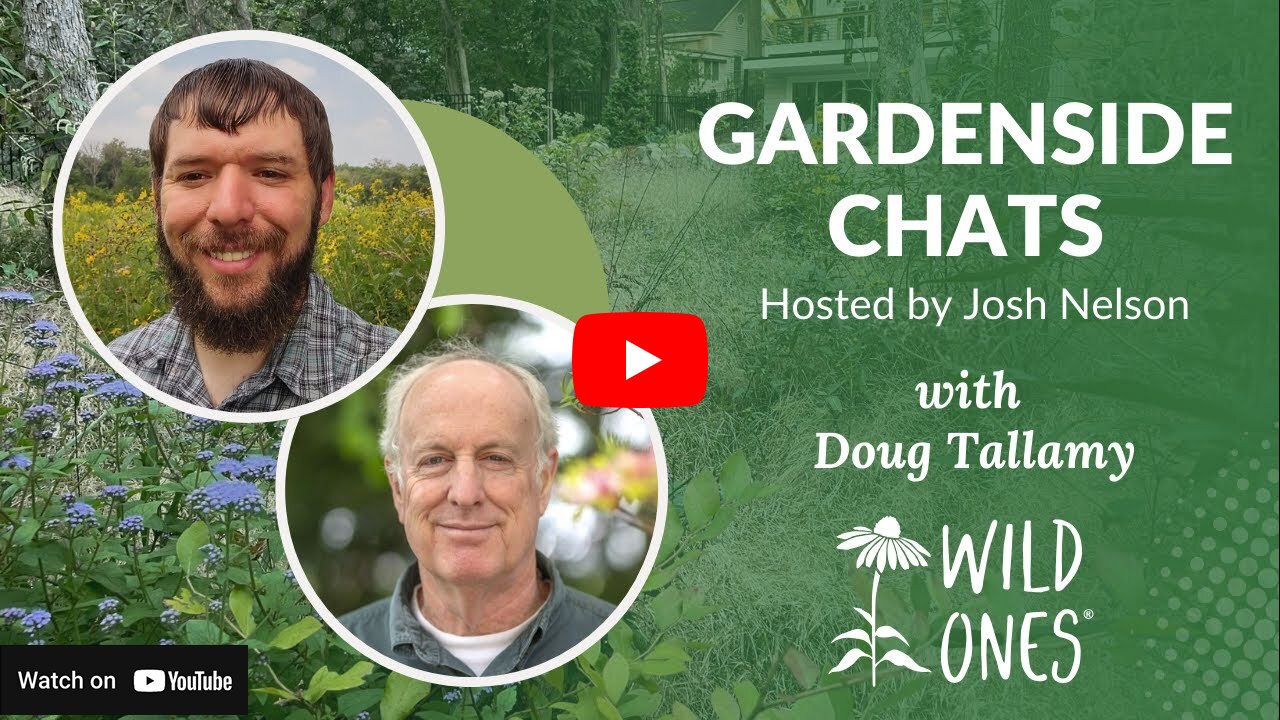If you’ve ever wondered how your yard can contribute to ecological restoration and biodiversity, Doug Tallamy’s insights provide an inspiring and practical roadmap.
In a recent conversation for Gardenside Chats, Wild Ones Development Director Josh Nelson hosted Doug Tallamy, a renowned author, entomologist, and Wild Ones Lifetime Honorary Director. Doug’s groundbreaking work has emphasized the vital role of native plants in supporting ecosystems and fostering biodiversity.
As we explore Doug’s journey and expertise, we learn how small changes in landscaping practices can yield profound ecological benefits, and why grassroots efforts are essential for addressing the biodiversity crisis.
Doug Tallamy’s Journey into Native Landscaping
Josh Nelson: Can you share your journey to becoming an advocate for native plants? Was there an “aha” moment that sparked your commitment to ecological restoration?
Doug Tallamy: My love for nature began early, but like many, I was initially drawn to animals, not plants. The turning point came during my childhood when a local pond—alive with toads, pollywogs, and other creatures—was bulldozed. That moment made a lasting impression, showing me the fragility of natural habitats. Later, when my wife and I moved to a property overtaken by invasive plants, I saw firsthand how replacing invasive species with native plants brought life back to the land. That experience shaped my research and advocacy for restoring natural ecosystems, one yard at a time.
Why Native Plants Matter
Josh Nelson: Your work has shown how native plants are critical for biodiversity. Why is it so important to restore native ecosystems, especially in residential landscapes?
Doug Tallamy: Insects and plants form the foundation of most ecosystems, and many insects can only use plants they’ve co-evolved with. When we replace native plants with non-native ones, we disrupt food webs and cause cascading effects on local wildlife. With 44 million acres of lawn in the U.S., much of it devoid of ecological value, restoring native plants in our yards can play a crucial role in reversing biodiversity loss. Even small efforts, like planting a tree or replacing a patch of lawn with native groundcover, can make a difference.
The Ripple Effect of Native Gardening
Josh Nelson: Do you have examples of how individual efforts have made an impact on communities or ecosystems?
Doug Tallamy: Absolutely. For instance, a tenth of an acre in Chicago became a haven for 127 bird species. Similarly, small suburban yards have supported dozens of native moths and caterpillars, which are vital food sources for birds. On my own property, we’ve documented over 1,300 moth species and 62 bird species breeding—proof that even degraded land can be transformed into a vibrant ecosystem. Imagine the impact if entire neighborhoods adopted native landscaping practices.
Advocacy Beyond Planting
Josh Nelson: Planting native species is essential, but what can people do to advocate for larger systemic change?
Doug Tallamy: Advocacy starts with education. Sharing your garden’s success can inspire neighbors and shift cultural norms. It’s also vital to engage with local policies—attend HOA meetings, advocate against mosquito fogging, and support roadside plantings of native species. Change requires persistence and collaboration, but as more people see the tangible benefits of native plants, it becomes easier to build momentum.
A Vision for the Future
Josh Nelson: What is your vision for the native landscaping movement, and how might our world look in 50 or 100 years if we embrace these practices?
Doug Tallamy: We must achieve a sustainable relationship with the ecosystems that sustain us. If we restore native plants on private and public lands, we can reverse biodiversity loss, mitigate climate change, and create a healthier planet. A century from now, I envision neighborhoods where native landscapes are the norm, supporting thriving ecosystems and resilient communities. It’s a hopeful vision, but it requires action today.
Fostering Change, One Yard at a Time
Doug’s conversation underscores the power of individual and community action in addressing the biodiversity crisis. From planting a single native tree to transforming entire neighborhoods, every effort matters. By working together to educate, advocate, and plant for a healthier future, we can ensure that native landscapes thrive across the nation.
Watch the full Gardenside Chat with Doug Tallamy

We’re thrilled to announce our newest national partnership between Wild Ones and Homegrown National Park! Much like Wild Ones, Homegrown National Park has inspired many people with their mission to regenerate biodiversity by adding native plants and removing invasive ones in the spaces we occupy daily.

Homegrown National Park provides an accessible, measurable way for people to become biodiversity heroes, visualizing the growing network of native habitats across the U.S. and Canada. This aligns perfectly with Wild Ones’ commitment to connecting people with the knowledge and tools they need to transform their outdoor spaces into thriving ecosystems.
We are both driven by our shared goal of protecting and restoring our natural landscapes by empowering individuals and communities to take action where they live, work, and play. By working together to share resources and support one another, we can amplify our collective impact to create healthier, more sustainable ecosystems.
Together, we’re creating a powerful relationship that will further inspire and support native landscaping on a national scale. As we move forward, we’re eager to explore innovative ways to engage our shared audiences, tackle the biodiversity crisis, and ensure future generations inherit a planet rich with the native plants and animals that sustain us all. This is more than a partnership; it’s a united call to action for a healthier, more vibrant planet!

